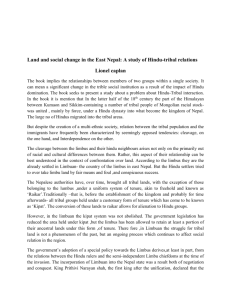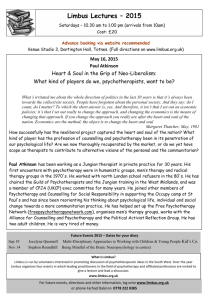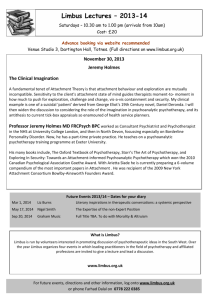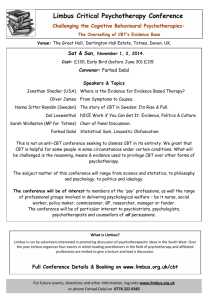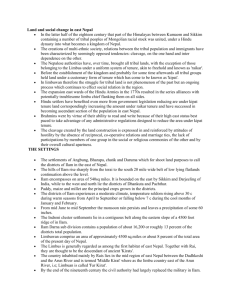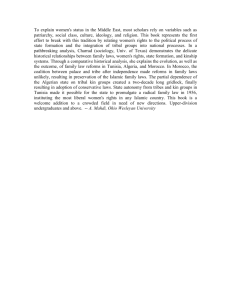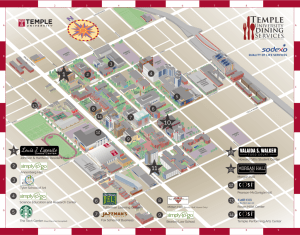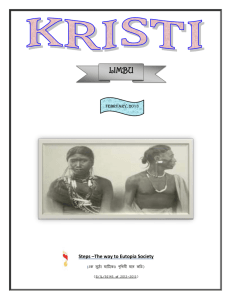Land and Social Change in East Nepal
advertisement
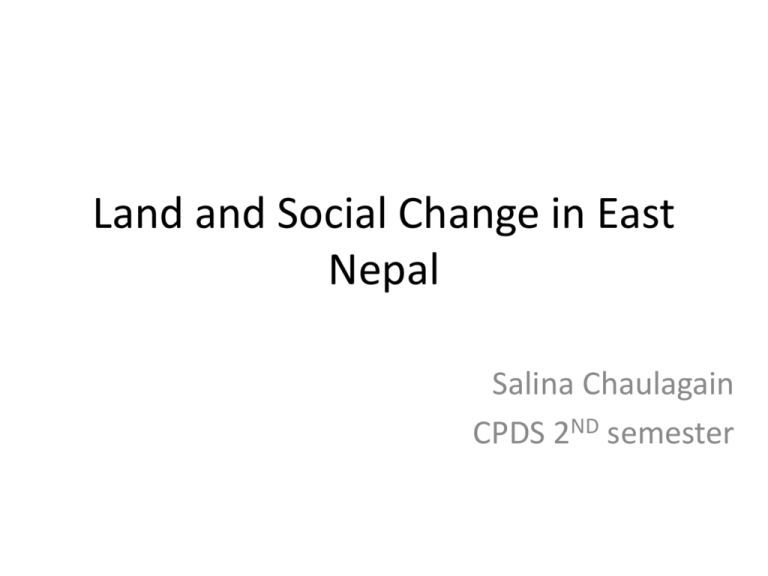
Land and Social Change in East Nepal Salina Chaulagain CPDS 2ND semester Sequence of presentation • Chapter 1 : Introductory • Chapter 2 : The Setting – Illam District – The Indreni Cluster • Chapter 3 : Land and Kin Groups – Clan and Local Clan Segment – Lineage – Household • Composition • Separation and Inheritence • Women’s Rights in Land – Limbus without Kipat Chapter 1 : Introductory • The spread of Hindu civilization throughout most of South Asia, advancing there by military conquest or by migration, has made the Hindu interaction with the tribal communities. • Break down of tribal character, evidenced in the loss of vitality and self-confidence, or in the assimilation of Hindu Habits. • Exposure to such Hindu influences such as improved agricultural techniques or more attractive bathing and dietary habits. Chapter 1 : Introductory… • The ways in which tribes adjust their cultural symbols to conform with the Brahmanical model and the two-way exchange of cultural traits with tribes being Hinduised and Hindu group is tribalised. • Hindu-tribal contact implies relationship between members of two groups which mean a significant change in tribal social institutions as a result of the impact of Hindu domination. Chapter 1 : Introductory… • After the establishment of Kingdom of Nepal, a huge migration of Hindus took place in the eastern part of Nepal resulting into the loss of land of the tribal people residing in those areas. • The Limbus made generous grants of land to accommodate the immigrant settlers which was later changed into Raiker tenure system, the majority of those receiving Limbu grants being Brahmins. • Initially the Limbus used to own land under the system of Kipat which later on was removed in the name of law by introducing the system of Raiker. Chapter 1 : Introductory… • Hindu settlers have benifited more from government legislation reducing the area under Kipat tenure. • In order to run the expenditure, the Limbus have had to pledge their lands and the creditor gets the right to cultivate in lieu of the interest as long as the loan is outstanding. • Hindus are anxious to have cultivation rights since their own raikar lands are in short supply depriving the Limbus of their legal rights to use their lands. Chapter 1 : Introductory… • However, Kipat land is not permanently alienable. The limbus only have to repay the loan to repossess the land. • The earnings from Gorkha regiments and considerable expansion in government services and economic activity are helping to repay the loan and repossess the land affecting the struggle for land and shaping the relationships between groups involved. Chapter 2 : The Setting • Illam District – Angbung, Bharapa, Chitok and Dorumba, named as Indreni Cluster, are situated in the Illam district – Illam lies in the hilly region with the heights of 11,000 feet above the sea level stretching from east to west along 500-mile length. – Area of Illam -540 sq miles with Sikkim and Darjeeeling in the east and Dhankutta and Panchthar to the west and north resp. – Irregular terrain and poor soil – terrace cultivation Chapter 2 : The Setting… • Illam District… – Paddy, Maize and Millet- principal crops – Moderate climate with temperature max 30 degree C from April to September and min 7 degree C during Jan and Feb. – Precipiataion – 60 inches – Mai, Pua Mai, Deo Mai and Jog Mai – main rivers – Indreni settlements lies along the eastern slope of a 4500-foot ridge in the Illam Darda sub-division of the district. – Illam is one of six districts in east Nepal which constitutes what is known as Limbuwan. Chapter 2 : The Setting… • Illam District… – Limbus are generally regarded as among the first inhabitants of east Nepal. – Recorded history of Limbus dates back to eighteen century when a number of small chiefdoms in Limbuwan were subject to the Kingdom of Bijayapur. – Later on after unification, Illam has largely been an important administrative unit due to its natural boundaries and strategic location. – After the restructuring of the country in 1962, Illam falls in Mechi zone of eastern development region Chapter 2 : The Setting… • The Indreni Cluster – Situated in the village of Syawa. – Heterogeneous population containing thirteen groups under Hindus, Limbus, other tribal groups, Newars and untouchables. – The houses are constructed on unirrigated plots keeping a small plot for growing mustard seed, potatoes, squashes, cabbages, cauliflowers, spinach, pumpkins, cucumbers, tomatoes, etc. – During dry seasons, men weave wicker baskets, repair ploughs or pass time in open courtyard while women pound and polish rice, wash utensils or brew millet beer. Chapter 2 : The Setting… • The Indreni Cluster… – Cattles and domestic animals are kept outside the house. – Most people live in one-room houses built of stone with thatched roof with no chimneys and proper ventilation. – Furniture is minimal even in most of the well-to-do families, people sleep on hay or bamboo mats. – Instead of nucleated villages, we find dispersed settlements which merge into one another. Chapter 2 : The Setting… • The Indreni Cluster… – Angbung is the most compact with every house within easy reach. – Wider distribution of houses in Bharapa than in Angbung with one cluster of six houses. – The residential pattern in Chitok is similar to that of Bharapa. – Houses in Dorumba are more widely spaced. – The settlements are neither exogamous nor endogamous units nor are the settlements bound together by any common rituals. Chapter 3 : Land and Kin Groups • Clan and Local Clan Segment – Limbus are divided into a number of named units which may be referred to as sub-tribes. – Over 80 clans over Limbus. – Particularly in the Indreni Cluster, five local clan segment can be found: Chongbung, Nembeke, Kambo, Phatra and Syeling. – By virtue of membership of such local clan segment a Limbu obtains rights of ownership to kipat land. Chapter 3 : Land and Kin Groups… • Lineage – The unilineal descent group which occurs when segmentation occurs within the local clan segment. – Lineage is the core of and to a large extent synonymous with the tax-paying unit. – The first settlers had staked out claims to lan and later their patrilineal descendants sought confirmation of their rights to hold these lands as Kipat. – Kipat taxes are leveled irrespective of the amount of land owned or cultivated. – Taxes are paid to government-approved tax-collectors or headmen (Subba). Chapter 3 : Land and Kin Groups… • Household – Over half of the households are of simple type consisting of husband, wife and their children – Others inlude widowed mothers or unmarried brothers of household heads. – Separation from the main household is generally in sequence with the eldest son leaving first followed by his younger brothers. – The exercise of inheritance rights by Indreni Limbus occasionally proceeds by stages so that separation of a son from the main household will not coincide with the final division of property. Chapter 3 : Land and Kin Groups… – On marriage, women forfeits all rights to the lands of her natal household. – Unmarried daughters however reaching the age of 35 can claim a share equal to one-half the inheritance of each male sibling. – If woman is the only child, she assumes rights in the entire estate following the death of her parents. – A daughter can only press her claims if she establishes a separate household. – The land cannot be gifted or in any way transmitted permanently to anyone other than male heirs. Chapter 3 : Land and Kin Groups… – Even to pledge the lands to third party an unmarried woman must have the permission of the potential male heirs. – Rights of a wife are similar to those of an unmarried daughter. – She cannot demand a share of separate estate. – If a man takes 2nd wife, then only she can establish a household for herself and her children if she has any. Chapter 3 : Land and Kin Groups… • Limbus without Kipat – Indreni cluster is also inhabited by a number of Limbus who are not members of Kipat-owing kin groups and so possess no ownership rights to this kind of land. – Usually the outsiders are the NKO Limbus. – NKOs are the patrilineal descendants of men who came to reside in their wives’ natal settlement. – They are not entitled for the right to Kipat.
